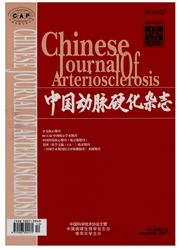

 中文摘要:
中文摘要:
目的研究巨细胞病毒感染引起的免疫损伤导致动脉粥样硬化发生的可能机制。方法载脂蛋白E基因敲除的8周龄(257BU6雌性小鼠,随机分成对照组、高脂饮食组、鼠巨细胞病毒感染组和高脂饮食+鼠巨细胞病毒感染组。在不同时间段分别处死小鼠,截取主动脉,利用逆转录聚合酶链反应、免疫组织化学等方法检测主动脉单核细胞趋化因子1、生长相关癌基因a、Fractalkine和调节活化正常T细胞表达与分泌的趋化因子的表达。结果第8周时,巨细胞病毒感染后可显著提高生长相关癌基因α在主动脉的表达,并可诱导Fractalkine、活化正常T细胞表达与分泌的趋化因子和单核细胞趋化因子1的表达,而在高脂饮食+巨细胞病毒感染的小鼠主动脉组织中,Fractalkine的表达较其它组明显升高。第12周时,高脂饮食+巨细胞病毒感染组中Fractalkine和活化正常T细胞表达与分泌的趋化因子和单核细胞趋化因子1的表达较其它组更高些。免疫组织化学结果发现,高脂饮食后,生长相关癌基因α、Fractalkine和单核细胞趋化因子1的表达均有明显升高,但Fractalkine的表达较局限,单核细胞趋化因子1和生长相关癌基因n在整个血管壁都存在,但以内膜较高。单纯巨细胞病毒感染组与高脂饮食组相似,可诱导单核细胞趋化因子1、生长相关癌基因α和Fractalkine的表达,但不同的是Fractalkine的表达广泛存在。而高脂饮食+巨细胞病毒感染组单核细胞趋化因子1、生长相关癌基因α和Fractalkine表达的升高更为明显,尤其是斑块部位。结论巨细胞病毒感染后通过调节趋化因子表达水平的改变,从而促进炎症细胞的迁移,促进动脉粥样硬化的发生。
 英文摘要:
英文摘要:
Aim To study the immmunologic injury mechanism of atherogenesis by mtwine cytomegalolovrus (MCMV) infection. Methods Animal model of atherosclerosis (C57BId6) with apolipoprotein E knockout mice were randomized to four groups: control group, hypercholesterol diet group, MCMV infection group, MCMV infection add hypercholesterol diet group, respectivcly. Mice from each group were sacrificed in different period. Portions of aortas were kept in - 80℃. The expression of monocyte chemaattractant protein-1 (MCP-1), growth-related oncogene-α (GRO-α), fractalldne (FKN) and regulated activation nonnal T cell expressed arid secreted (RANTES) in aortas were detected by RT-PCR and inm,unnbdstochemistry. Results In the 8th week, the expression of GRO-α in aorta tissues was significant by CMV infection, and the expression of FKN, RANFES aJld MCP-1 was induced. The expression of FEN was more significant in MCMV infection add hypercholesterol diet group than other groups. In the 12th week, the expression of FKN and RANTES was marked than others. Inununohistochemistry staiting also showed that the expression of MCP-1, GRO-α asld FKN was enhanced in athemsclerotic lesion, but expression of FKN was variable, and correlated with the atherosdemtic plaque. Condusion MCM'V infection could contribute to atherogenesis by inducing file expression of chemokines and enhance the migration of inflammatory cells.
 同期刊论文项目
同期刊论文项目
 同项目期刊论文
同项目期刊论文
 Phospholipase Cgamma1 signalling regulates lipopolysaccharide-induced cyclooxygenase-2 expression in
Phospholipase Cgamma1 signalling regulates lipopolysaccharide-induced cyclooxygenase-2 expression in The Modualtion Effects of Momordicin on Cardiac TNF-( in the Balb/c Murine Model of Coxsickievirus B
The Modualtion Effects of Momordicin on Cardiac TNF-( in the Balb/c Murine Model of Coxsickievirus B Effect and mechanism of astragaloside on cardiac matrix deposition in murine dilated cardiomyopathya
Effect and mechanism of astragaloside on cardiac matrix deposition in murine dilated cardiomyopathya Assessment of left ventricular systolic synchronicity by real-time three- dimensional echocardiograp
Assessment of left ventricular systolic synchronicity by real-time three- dimensional echocardiograp 期刊信息
期刊信息
